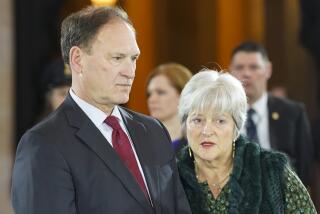Justice Ruth Bader Ginsburg signals she has no plans to retire soon
- Share via
REPORTING FROM WASHINGTON — When Justice Ruth Bader Ginsburg walked from behind a stage curtain on a recent Friday afternoon, a huge roar went up from the jammed auditorium at George Washington University.
“Everyone here is thrilled to be in the presence of the Notorious R.B.G.!” said law professor Maeva Marcus, setting off another round of hoots from a mostly young crowd delighted by the reference to the late rapper Notorious B.I.G.
The justice soaked in the warm reception, but Ginsburg admitted that when she first heard the reference she asked her law clerks: “What’s this ‘notorious’?”
At 81, Ginsburg has emerged as the Supreme Court’s liberal leader, its strongest voice for women’s rights and an increasingly outspoken critic of the court’s conservative majority. And to her surprise, she has also become a celebrity and a star on the Web for a younger generation of law students and political activists. A “Notorious R.B.G.” Tumblr site is devoted to the words and wisdom of the justice, including T-shirts featuring her picture.
This fall, as she begins her 22nd year on the high court, Ginsburg is at the height of her influence and public acclaim, but she also faces a decision that may be the most consequential of her career: Should she retire when the term ends in June so President Obama can name her successor?
Early in her career, Ginsburg said she aspired to match her hero, Justice Louis D. Brandeis, who served 22 years on the court and retired when he was 82.
Ginsburg, who will turn 82 in March, has sent signals that she has no plans to quit soon, saying she will continue as long as she can go “full steam.”
Her friends and former law clerks have rallied to her defense.
“She is clearly at the top of her game,” said Washington lawyer Lisa Blatt, a clerk for Ginsburg when she served on the U.S. Court of Appeals. “She is taking on a huge leadership role, and she has never been more engaged. Because of her seniority, her voice comes through loud and clear. She is not going to be intimidated by people saying it’s time to leave.”
But while most on the left laud Ginsburg’s work, some worry her legacy could be tarnished if she stays beyond 2015. Their fear is that if a Republican wins the White House in 2016, she could be replaced by a staunch conservative.
They well remember when Justice Thurgood Marshall, the legendary civil rights lawyer, was ailing and decided to retire in 1991, just shy of his 83rd birthday. His seat was filled by Justice Clarence Thomas, who for the last two decades has been the court’s most conservative justice.
Harvard law professor Randall Kennedy and UC Irvine Law School Dean Erwin Chemerinsky wrote op-ed pieces urging Ginsburg to retire.
“The best way for her to advance all the things she has spent her life working for is to ensure that a Democratic president picks her successor,” Chemerinsky wrote in March. He noted that if a conservative fills her seat, the court could well have a majority to overturn the landmark abortion case Roe vs. Wade.
Ginsburg’s admirers say she still plays a necessary and vital role on the court.
Earlier in her court career, Ginsburg was cautious and restrained, voting with the liberal bloc but rarely raising her voice. But in recent years, she has spoken out against what she has called conservative activism.
“She has been the voice of principled resistance” in cases involving abortion, contraceptives and equal rights, said Duke law professor Neil Siegel.
In 2007, she called on Congress to reverse the court’s 5-4 decision in the Lilly Ledbetter case, which threw out a sex-discrimination claim won by an Alabama woman on the grounds that she had waited too long to sue. Ginsburg said her colleagues were blind to the “realities of the workplace,” since most employees do not know whether they are paid less than others for doing the same job.
In response, Congress passed the Lilly Ledbetter Fair Pay Act, and Obama signed it into law soon after taking office.
Last year, Ginsburg read a long dissent in court when a 5-4 majority struck down part of the Voting Rights Act. In June, she delivered another sharp dissent when the court, by a 5-4 vote in the Hobby Lobby case, ruled Christian business owners had a religious-liberty right to refuse to pay for the full range of birth control methods that were made part of health insurance by the Affordable Care Act. The five men who formed the majority had a “blind spot,” Ginsburg said in one interview, and did not see the importance of these contraceptives for working women.
In response to growing questions about her retirement plans, Ginsburg sometimes cites the recent departures of two colleagues.
Justice Sandra Day O’Connor decided to retire at age 75 in 2005 and later regretted the court’s move to the right when the more conservative Justice Samuel A. Alito Jr. replaced her. Justice John Paul Stevens stayed on the job through his 80s and remained mentally sharp and highly productive. He retired at 90 and has gone on to write books on the Constitution.
In recent weeks, Ginsburg was making a round of public appearances this month in what might be called the “full steam” tour. She spoke at the Chicago Bar Assn., addressed a women’s health conference in New York and discussed her work as a 1970s ACLU attorney at GWU and the University of Minnesota. She also presided over a same-sex marriage in Brooklyn: one of her recent law clerks wed his partner.
An opera fan, she made her regular summer visit to New Mexico in August to take in four productions of the Santa Fe Opera. While there, she spoke about the Constitution and its opening words: “We the people of the United States.”
Ginsburg likes to point out that when the Constitution was written in 1787, its legal protections did not extend to most of the people of the United States, including women, African Americans, Native Americans and even white men who did not own property. Her message was that the Constitution has grown as the nation has grown, and it should not be interpreted according to its original meaning in the 18th century.
That viewpoint could be key in the next term if the court takes up the question of whether gays and lesbians have a constitutional right to marry. Her friend Justice Antonin Scalia, 78, is the leading advocate for the “original meaning” interpretation of the Constitution, and the two will surely be on opposite sides.
Admirers say the potential same-sex-marriage case and other upcoming issues underscore the need to have Ginsburg on the court. They note that since women have a longevity advantage over men, the justice may have many more years on the bench.
“She’s been an utterly essential voice on women’s rights,” said Marcia Greenberger, co-president of the National Women’s Law Center. “I’m hopeful we will have many more years when we can benefit from Justice Ginsburg’s wisdom on the bench.”
More to Read
Sign up for Essential California
The most important California stories and recommendations in your inbox every morning.
You may occasionally receive promotional content from the Los Angeles Times.











